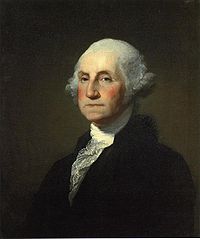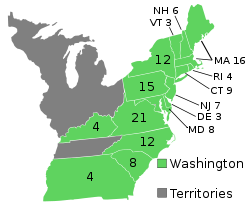- United States presidential election, 1792
-
United States presidential election, 1792 
1788-1789 ← 1792 → 1796 
Nominee George Washington Party Independent Home state Virginia Electoral vote 132 States carried 15 Popular vote 13,332 Percentage 100%
Presidential election results map. Numbers indicate the number of electoral votes allotted to each state.
President before election
Elected President
The United States presidential election of 1792 was the second presidential election in the United States, and the first in which each of the original 13 states appointed electors (in addition to newly-added states of Kentucky and Vermont). It is also the only presidential election that was not held four years after the previous election, although part of the previous election was technically held four years prior.
As in 1789, George Washington, now president, ran unopposed. Under the system in place then and through the election of 1800, each voting elector cast two votes — the recipient of the greatest number of votes was elected president, the second greatest number, vice-president. As in his first term, Washington is considered to have been elected unanimously.
The recipient of 77 electoral votes, Vice-President John Adams finished second in voting and was therefore re-elected.
Contents
Presidential candidates
- George Washington, President of the United States from Virginia
Vice Presidential candidates
Federalist candidates
- John Adams, Vice President of the United States from Massachusetts
Candidates gallery
Democratic-Republican candidates
- George Clinton, Governor of New York
Candidates gallery
Campaign
By 1792, a party division had emerged between Federalists led by Treasury Secretary Alexander Hamilton, who desired a stronger federal government with a leading role in the economy, and the Democratic-Republicans led by Secretary of State Thomas Jefferson and Representative James Madison, who favored states' rights and opposed Hamilton's economic program. Madison was at first a Federalist until he opposed the establishment of Hamilton's First Bank of the United States in 1791. He formed the Democratic-Republican Party along with Anti-Federalist Thomas Jefferson in 1792.
The elections of 1792 were the first ones in the United States to be contested on anything resembling a partisan basis. In most states, the congressional elections were recognized in some sense as a “struggle between the Treasury department and the republican interest,” to use the words of Jefferson strategist John Beckley. In New York, the race for governor was fought along these lines. The candidates were Chief Justice John Jay, a Hamiltonian, and incumbent George Clinton, who was allied with Jefferson and the Democratic-Republicans.
Although Washington had been considering retiring, both sides encouraged him to remain in office to bridge factional differences. Washington was supported by practically all sides throughout his Presidency and gained more popularity with the passage of the Bill of Rights. However, the Democratic-Republicans and the Federalists contested the vice-presidency, with incumbent John Adams as the Federalist nominee and George Clinton as the Democratic-Republican nominee. With some Democratic-Republican electors voting against their nominee George Clinton - voting instead for Thomas Jefferson and Aaron Burr - Adams easily secured re-election.
Results
The Electoral College chose Washington unanimously. John Adams was again elected vice-president as the runner-up, this time getting the vote of a majority of electors. George Clinton won the votes of only Georgia, North Carolina, Virginia, his native New York, and a single elector in Pennsylvania. Thomas Jefferson won the votes of Kentucky, newly separated from Jefferson's home state of Virginia. A single South Carolina elector voted for Aaron Burr.
Only 13,332 popular votes were cast for presidential electors, a record low turnout for a United States presidential election.
Popular vote
Slate Popular Vote(a), (b), (c) Count Percentage Federalist electors 9,478 71.1% Democratic-Republican electors 3,854 28.9% Total 13,332 100.0% Source: U.S. President National Vote. Our Campaigns. (February 11, 2006).
(a) Only 6 of the 15 states chose electors by any form of popular vote.
(b) Less than 0.5% of the population voted: the 1790 Census counted a total United States population of 3.9 million with 3.2 million free population and 700 thousand slaves
(c) Those states that did choose electors by popular vote had widely varying restrictions on suffrage via property requirements.Electoral vote
Presidential Candidate Party Home State Popular Vote(a) Electoral Vote(b) Count Percentage George Washington Independent Virginia 13,332 100.0% 132 John Adams Federalist Massachusetts — — 77 George Clinton Democratic-Republican New York — — 50 Thomas Jefferson Democratic-Republican Virginia — — 4 Aaron Burr Democratic-Republican New York — — 1 Total 13,332 100.0% 264 Needed to win 67 Source: Electoral College Box Scores 1789–1996. Official website of the National Archives. (July 30, 2005).
(a) Popular vote figures are suspect because (1) only 6 of the 15 states chose electors by any form of popular vote, (2) pre-Twelfth Amendment electoral vote rules obscure the intentions of the voters, and (3) those states that did choose electors by popular vote often restricted the vote via property requirements.
(b) Two electors from Maryland and one elector from Vermont did not cast votes.Electoral college selection
Method of choosing Electors State(s) state is divided into electoral districts, with one elector chosen per district by the voters of that district Kentucky
Virginiaeach elector chosen by voters statewide Maryland
Pennsylvania- two Congressional districts chose five electors each; the remaining two districts chose three electors each
- each elector chosen by majority vote of voters in Congressional district
- if an insufficient number of electors are chosen by majority vote from a Congressional district, remaining electors would be appointed by the state legislature
Massachusetts - each elector chosen by majority vote of voters statewide
- if an insufficient number of electors are chosen by majority vote, runoff is held between the top 2n vote-getters, where n is the number of vacancies remaining
New Hampshire each elector appointed by the state legislature (all other states) See also
- First Party System
- History of the United States (1789–1849)
- United States House election, 1792
References
- Berg-Andersson, Richard (2000-09-17). "A Historical Analysis of the Electoral College". The Green Papers. http://www.thegreenpapers.com/Hx/ElectoralCollege.html. Retrieved March 20, 2005.
- Elkins, Stanley; McKitrick, Eric (1995). The Age of Federalism. Oxford University Press.
- A New Nation Votes: American Election Returns, 1787-1825
 United States presidential elections
United States presidential elections1788 · 1792 · 1796 · 1800 · 1804 · 1808 · 1812 · 1816 · 1820 · 1824 · 1828 · 1832 · 1836 · 1840 · 1844 · 1848 · 1852 · 1856 · 1860 · 1864 · 1868 · 1872 · 1876 · 1880 · 1884 · 1888 · 1892 · 1896 · 1900 · 1904 · 1908 · 1912 · 1916 · 1920 · 1924 · 1928 · 1932 · 1936 · 1940 · 1944 · 1948 · 1952 · 1956 · 1960 · 1964 · 1968 · 1972 · 1976 · 1980 · 1984 · 1988 · 1992 · 1996 · 2000 · 2004 · 2008 · 2012
Electoral College · Electoral vote changes · Electoral votes by state · Results by Electoral College margin · Results by popular vote margin · Results by state · Voter turnout · Presidential primaries · Presidential nominating conventionsSee also: House elections · Senate elections · Gubernatorial elections
Wikimedia Foundation. 2010.




